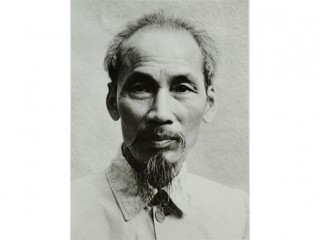
Nguyen Sinh Cung biography
Date of birth : 1890-05-19
Date of death : 1969-09-03
Birthplace : Kim Lien, Vietnam
Nationality : Vietnamese
Category : Arts and Entertainment
Last modified : 2010-05-12
Credited as : Communist revolutionary, President of the Democratic Republic of Vietnam,
Hồ led the Viet Minh independence movement from 1941 onward, establishing the communist-governed Democratic Republic of Vietnam in 1945 and defeating the French Union in 1954 at Dien Bien Phu. He lost political power inside North Vietnam in the late 1950s, but remained as the highly visible figurehead president until his death. The former capital of South Vietnam, Saigon, after the Fall of Saigon, was renamed Hồ Chí Minh City in his honor.
Leading an interesting life abroad in the United States, England, France, Russia, and China, Ho Chi Minh became aware of the freedoms of the individual. He would work his way to becoming the prime minister and president of Vietnam and one of the country’s most respected and remembered leaders.
He grew up with some privilege under the French occupation of Vietnam. Ho Chi Minh was a gifted student and received a Confucian upbringing from his father during his childhood. He attended a French High School along Vietnam’s coastal town of Hue. After finishing school, Ho Chi Minh went to Marseille and attempted to go to an administrative school, but was denied.
Ho Chi Minh then traveled to the United States. He arrived in Boston and immediately felt that he was in a different, free world. His experiences in Boston and later in New York City would inspire him later when he played America’s national anthem and quoted the United States’ Declaration of Independence after coming into power. He couldn’t believe the rights and civil liberties he enjoyed as an immigrant, even while working the most menial of jobs.
Ho Chi Minh returned to Vietnam and visited Saigon for a while. He then traveled as a cabin boy back to Marseille; again doing menial jobs that would abide him financially and give him free passage. He enjoyed his time in France, but headed to England and lived there for three years. He worked and trained as a pastry chef. He began reading more and fine-tuning his political stance during those years. He returned to France for another three years, and after World War I attempted to gain equal rights for those in Indochina who were under French Rule. He even asked President Woodrow Wilson for help from the United States, but was ignored. Ho Chi Minh then went to Moscow where he would learn more about Communism.
Ho Chi Minh then started Youth Education Classes to teach the youth about the horrible conditions for those under French rule. He traveled to Hong Kong as a Communist Representative and was arrested and held for a number of years. In the early 1940s, he returned to Vietnam to lead the independence movement with success. After a military campaign called the August Movement, he became Chairman of the Provisional Government. He contacted President Truman in an attempt for him to recognize Vietnam’s independence, but again was ignored by the international community. Ho Chi Minh’s government assassinated, murdered, and flushed the country of opposition. Thousands were killed and thousands of others fled for their lives. Once Ho Chi Minh had complete power, he read the newly written Declaration of the Democratic Republic of Vietnam. In 1950, the Soviet Union acknowledged Ho Chi Minh’s newfound government and gained their support. He would now be able to ward off French rule in his country forever. His body was later be entombed with other Communist leaders in Moscow.
















